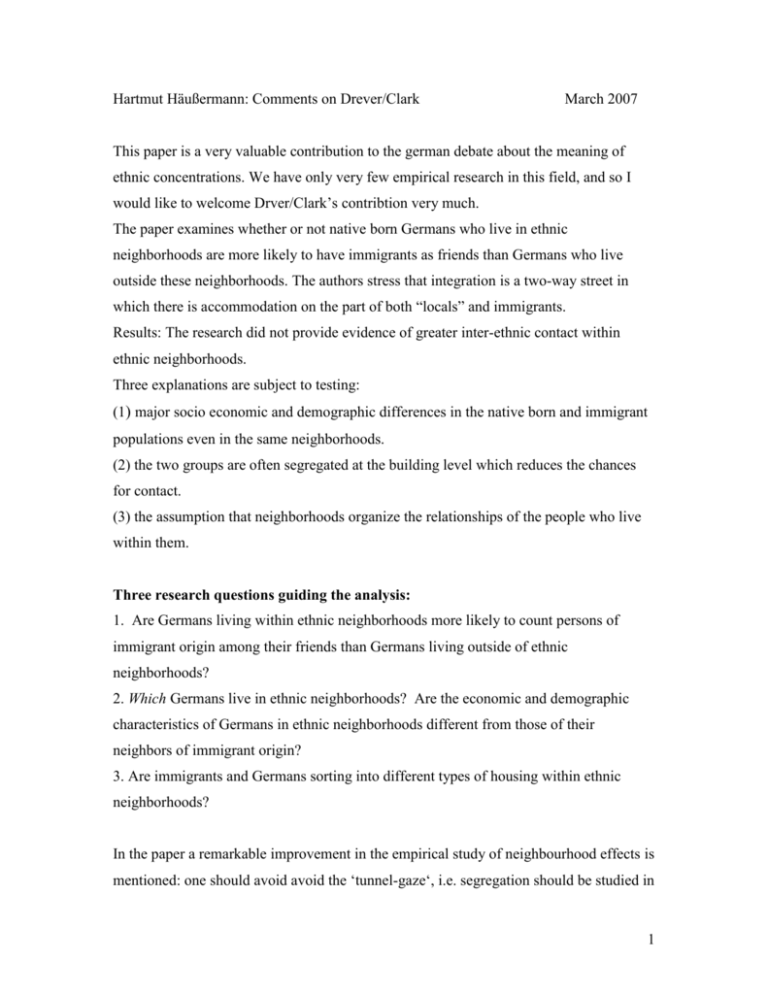Mixed neighborhoods, parallel lives
advertisement

Hartmut Häußermann: Comments on Drever/Clark March 2007 This paper is a very valuable contribution to the german debate about the meaning of ethnic concentrations. We have only very few empirical research in this field, and so I would like to welcome Drver/Clark’s contribtion very much. The paper examines whether or not native born Germans who live in ethnic neighborhoods are more likely to have immigrants as friends than Germans who live outside these neighborhoods. The authors stress that integration is a two-way street in which there is accommodation on the part of both “locals” and immigrants. Results: The research did not provide evidence of greater inter-ethnic contact within ethnic neighborhoods. Three explanations are subject to testing: (1) major socio economic and demographic differences in the native born and immigrant populations even in the same neighborhoods. (2) the two groups are often segregated at the building level which reduces the chances for contact. (3) the assumption that neighborhoods organize the relationships of the people who live within them. Three research questions guiding the analysis: 1. Are Germans living within ethnic neighborhoods more likely to count persons of immigrant origin among their friends than Germans living outside of ethnic neighborhoods? 2. Which Germans live in ethnic neighborhoods? Are the economic and demographic characteristics of Germans in ethnic neighborhoods different from those of their neighbors of immigrant origin? 3. Are immigrants and Germans sorting into different types of housing within ethnic neighborhoods? In the paper a remarkable improvement in the empirical study of neighbourhood effects is mentioned: one should avoid avoid the ‘tunnel-gaze‘, i.e. segregation should be studied in 1 work, school and recreational spaces as well as residential spaces. There is increasing evicence for “ethnic communities without propinquity –in other words tightly knit ethnic communities whose members’ residences are scattered throughout the urban landscape”. (Drever/Clark) The empirical analysis has two steps. 1. The paper argues at the first step, Germans and migrants living in the same neighbourhood do not meet because of different consumption patterns, incomes, and needs for space. “They share the neighbourhood, but they do not share the spaces.” A possible strengthening for empirical research of contacts would be the distinction between ‘meeting’ and ‘mating’, used by Andeas Farwick in his study on ethnic segregation in Bremen last year. Space is not just space, and contacts are not just contacts. There are spaces with unavoidable contacts, like schools f.e. How far are these shared spaces? Decisive for the expectation, that neighbourhoods would provide opportunities for contacts which are useful for integration, is who is living in the ethnic neighbourhoods. We learn too few about the social position of the Germans. Data indicating the social position of those germans, who live in the ethnic neighbourhood and those, who do not, would be very much welcome. We need these data for the evaluation of heterogeneity of homogeneity of the people in the neighbourhoods. Are they ethnically diverse, but similar in terms of social position? Social homogeinity could mean, that in segregated areas there are loosers on both (ethnic) sides? And this would possibly imply competition, conflict about resources. Non-communication or non-mating could be explained so. A last question: Are ‘ethnic neighbourhoods’ one type indeed? You find there different Germans: singles, without children, older people, higher income, better education – and high unemployment, welfare recipients, the excluded. Who is living with whom? I would suppose that Kreuzberg and Wedding are very different types of ethnic neighbourhoods. My last comment is a queation to the authors: am I right if I see a change in the analytical concept in the paper itself? If you stress (and I would support this) the importance of 2 socio-economic factors for your results, why do you explore the age of the buildings? Furthermore: is ‘not-sharing of space’ a matter of scale? Would it be different, if they lived in the same house? Andreas Farwicks results strongly suggest such a conclusion. Does space defeat socio-economic influences if people share the same stairways – but not in the neighbourhood? 3







